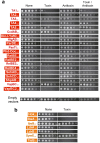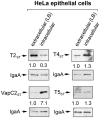Distinct type I and type II toxin-antitoxin modules control Salmonella lifestyle inside eukaryotic cells
- PMID: 25792384
- PMCID: PMC4366850
- DOI: 10.1038/srep09374
Distinct type I and type II toxin-antitoxin modules control Salmonella lifestyle inside eukaryotic cells
Abstract
Toxin-antitoxin (TA) modules contribute to the generation of non-growing cells in response to stress. These modules abound in bacterial pathogens although the bases for this profusion remain largely unknown. Using the intracellular bacterial pathogen Salmonella enterica serovar Typhimurium as a model, here we show that a selected group of TA modules impact bacterial fitness inside eukaryotic cells. We characterized in this pathogen twenty-seven TA modules, including type I and type II TA modules encoding antisense RNA and proteinaceous antitoxins, respectively. Proteomic and gene expression analyses revealed that the pathogen produces numerous toxins of TA modules inside eukaryotic cells. Among these, the toxins HokST, LdrAST, and TisBST, encoded by type I TA modules and T4ST and VapC2ST, encoded by type II TA modules, promote bacterial survival inside fibroblasts. In contrast, only VapC2ST shows that positive effect in bacterial fitness when the pathogen infects epithelial cells. These results illustrate how S. Typhimurium uses distinct type I and type II TA modules to regulate its intracellular lifestyle in varied host cell types. This function specialization might explain why the number of TA modules increased in intracellular bacterial pathogens.
Figures





Similar articles
-
Toxin-antitoxins and bacterial virulence.FEMS Microbiol Rev. 2016 Sep;40(5):592-609. doi: 10.1093/femsre/fuw022. Epub 2016 Jul 29. FEMS Microbiol Rev. 2016. PMID: 27476076 Review.
-
Type II Toxin-Antitoxin Systems: Evolution and Revolutions.J Bacteriol. 2020 Mar 11;202(7):e00763-19. doi: 10.1128/JB.00763-19. Print 2020 Mar 11. J Bacteriol. 2020. PMID: 31932311 Free PMC article. Review.
-
Dynamics of Salmonella small RNA expression in non-growing bacteria located inside eukaryotic cells.RNA Biol. 2012 Apr;9(4):469-88. doi: 10.4161/rna.19317. Epub 2012 Feb 16. RNA Biol. 2012. PMID: 22336761
-
A bacterial toxin-antitoxin module is the origin of inter-bacterial and inter-kingdom effectors of Bartonella.PLoS Genet. 2017 Oct 26;13(10):e1007077. doi: 10.1371/journal.pgen.1007077. eCollection 2017 Oct. PLoS Genet. 2017. PMID: 29073136 Free PMC article.
-
Computational insights into promoter architecture of toxin-antitoxin systems of Mycobacterium tuberculosis.Gene. 2018 Jan 30;641:161-171. doi: 10.1016/j.gene.2017.10.054. Epub 2017 Oct 21. Gene. 2018. PMID: 29066303
Cited by
-
RNA Regulated Toxin-Antitoxin Systems in Pathogenic Bacteria.Front Cell Infect Microbiol. 2021 May 18;11:661026. doi: 10.3389/fcimb.2021.661026. eCollection 2021. Front Cell Infect Microbiol. 2021. PMID: 34084755 Free PMC article. Review.
-
Contribution of Toxin-Antitoxin Systems to Adherent-Invasive E. coli Pathogenesis.Microorganisms. 2024 Jun 6;12(6):1158. doi: 10.3390/microorganisms12061158. Microorganisms. 2024. PMID: 38930540 Free PMC article. Review.
-
Functional genomics reveals the toxin-antitoxin repertoire and AbiE activity in Serratia.Microb Genom. 2020 Nov;6(11):mgen000458. doi: 10.1099/mgen.0.000458. Microb Genom. 2020. PMID: 33074086 Free PMC article.
-
In Silico Analysis of Genetic VapC Profiles from the Toxin-Antitoxin Type II VapBC Modules among Pathogenic, Intermediate, and Non-Pathogenic Leptospira.Microorganisms. 2019 Feb 20;7(2):56. doi: 10.3390/microorganisms7020056. Microorganisms. 2019. PMID: 30791633 Free PMC article.
-
Type I Toxin-Antitoxin Systems in Clostridia.Toxins (Basel). 2019 May 6;11(5):253. doi: 10.3390/toxins11050253. Toxins (Basel). 2019. PMID: 31064056 Free PMC article. Review.
References
-
- Bravo A., de Torrontegui G. & Diaz R. Identification of components of a new stability system of plasmid R1, ParD, that is close to the origin of replication of this plasmid. Mol. Gen. Genet. 210, 101–110 (1987). - PubMed
-
- Gerdes K. in Prokaryotic toxin-antitoxins (Springer, 2013).
-
- Hayes F. & Van Melderen L. Toxins-antitoxins: diversity, evolution and function. Crit. Rev. Biochem. Mol. Biol. 46, 386–408 (2011). - PubMed
Publication types
MeSH terms
Substances
LinkOut - more resources
Full Text Sources
Other Literature Sources

